Caring for Your Animals
When you begin your life in Echo Village, your farm will have one livestock barn. On Spring 9, Neil will stop by and deliver a free cow to your farm, along with a Pitchfork, Milker, and Brush. You can buy more animals from him at his Animal Shop in the open market plaza area Monday through Thursday.
To raise chickens, you'll need to wait until Spring 25. Rebecca will give you a walkthrough on how to use your construction workshop to build things, and after that the blueprint for the Coop will be available in her shop inventory. You need to build a Coop before Neil will sell normal Chickens at his shop.
Each barn can hold a maximum of 10 animals, and will contain an animal notebook inside that gives you access to your animals' profile information. The Animal Information notebook inside the Barn displays data relating to cows, sheep, Alpacas, Yaks, and Llamas, while the same notebook in the Coop covers your Chickens and Silkie Chickens:
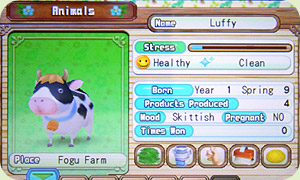
- The profile page will display the animal's Name at the top of the window. The name can be 6 characters long. If you discover that your animal's name has become "????," it is because the name you selected matched one of the filtered words when you used the multi-player wifi trading system.
- The animal's Stress and Health comes next. The blue stress bar will fill if the animal becomes unhappy; a stressed animal can become sick and will eventually die if you don't tend to it. The health indicates if the animal is sick or not. For non-poultry animals, there will also be a Clean status. Dirty animals will become stressed, so clean them with the Brush every three days.
- The next area covers the animal's Age, Products Produced, Mood, Pregnancy Status, and Festival Wins. For purchased animals, the date listed for the "Born" will be the day you bought it and not the date that it was born or hatched before you paid for it. The number of products the animal makes can be influenced by feeding it special treats. The listed mood is just the personality of the animal and has no factor in the game that I've been able to determine. The pregnancy status indicates if your livestock animal is currently pregnant; chickens will always have "no" for their Pregnant status. And every time you win a festival using that specific animal, the number of Times Won will increase.
- The graphic icons at the bottom of the screen will tell you the interactions the animal has had today. Livestock animals will have a green fodder icon indicating if it has eaten this day, while the chickens will have a chicken feed bag icon instead. You can also see if it produced goods, if you've talked or brushed it this day, or if you've fed it a special treat.
- Lastly will be the animal's Place. This will tell you where on your farm this animal lives. At the beginning of the game you only have your main farm area, but as you complete the Restoration Plans, your farm area will expand. You can place an additional Barn and Coop in each expanded area, so the location marker will indicate which area's barn this animal resides.
Feeding
Every day your animals need to be fed. You can buy Fodder and Chicken Feed from Neil's shop. All of your livestock animals will eat Fodder, and all of the poultry will eat Chicken Feed. You can grow your own Fodder by planting Grass Seed into fields, but there is no way to make your own Chicken Feed.
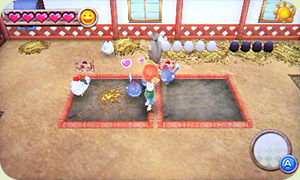
Chickens in this version of Harvest Moon do not forage for food, so you must feed them every day. Place Chicken Feed into their feed troughs inside the Coop. If you want to feed the chickens outside, you will have to build a Chicken Feeder and place it near your Coop, then put Chicken Feed into the outdoor feeder every day. It's easier to feed them indoors though, since once they return from being outside for the day they'll just eat from their indoor feed trays. You do not want to leave chickens (or any livestock animal) outside overnight, else their stress will increase. Chickens will only lay eggs when inside their Coop.
You also need to feed your baby animals, both livestock and poultry.
Livestock animals can be fed by placing Fodder into their Barn feed trough, but on sunny or snowy days you can let them outside to graze on grass. Grass Seed can be bought from the General Store for 20 G a bag. The type of field you grow the Fodder grass in will not matter, as Fodder only takes two days to mature, regrows every day, and does not have a Star Rank.
You will need one mature grass per livestock animal you own. When a grass plant has been eaten 30 times by an animal, it will go away. The description on the bag of seed indicates that you can cut it with your Sickle (to make your own Fodder) for 30 days, but it actually means it can be harvested 30 times; Fodder won't wilt away after 30 days if it is left untouched. Grass is not season-specific and will grow all year long.
Since Fodder grows back ever day, you can harvest and ship the excess Fodder that you don't need. You can earn 60 G per piece of Fodder (480 G per 8-square field per day).
When feeding your animals indoors, one piece of food will take care of 5 animals. Uneaten food will eventually become Barn Dirt, which you pick up off the ground by using the Pitchfork. Barn Dirt does not have any special purpose, so you can ship it for 10 G a piece.
Care and Attention
Taking good care of your animals will increase their Friendship Points and keep their stress level low. The happier the animal is, the more money you'll earn for shipping its products.
Friendship Hearts
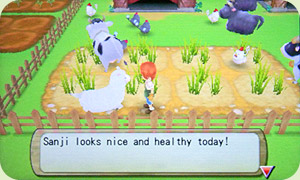
Inside the Animal Information notebooks, on your Nintendo 3DS lower touch screen, you'll see the friendship hearts. The more hearts your animal has, the higher the Star Rank of the items it will produce. You'll also have a better chance of winning the seasonal animal festivals with contest entries that have maximum heart levels.
Each heart on its friendship meter is 100 Friendship Points; a half heart is 50 points and a full heart is 100 points. The maximum number of hearts you can have is 10, or 1000 FP. Daily interaction with your animals (or no interaction) will increase or decrease their Friendship Points. Each type of animal you own will react to your affection a little bit differently; for example, Suffolk Sheep are a little harder to increase hearts with than regular Sheep.
- Animal interaction: Each day you will want to do something with the animals, whether it is just talk
to them, harvest products, or brush them. The attention you give your animals will increase their Friendship
Points each day. Doubling-up on attention won't earn your additional points (i.e., talking to your Cow
will not earn you +1 FP each time).
- Friendship Earned From Picking Up: +1 FP for Chickens and Silkies.
- Friendship Earned From Talking: +1 FP for Cows, Jerseys, Yaks, Sheep, Suffolk, Alpaca, and Llamas.
- Friendship Earned From Brushing: +2 FP for Cows, Jerseys, Yaks, Alpacas, and Llamas. +3 for Suffolk. +4 for Sheep.
- Friendship Earned From Milking: +1 FP for Cows, Jerseys, and Yaks.
- Friendship Earned From Sheering: +1 for Llama. +2 for Suffolk and Alpacas. +4 for Sheep.
- Friendship Earned From Laying an Egg: +1 for Chickens and Silkies.
- Friendship Earned From Feeding it a Regular Treat: +1 FP to the fed animal.
- Friendship Earned From Feeding it an Animal Specific Treat: +2 FP to the fed animal.
- Hearing the Bell: You can make a Bell tool using your construction workshop or buy it from Neil for 300 G. The handheld Bell, when you use it, will entice the animals to walk towards you. The more hearts the animal has, the farther away you can be and still have the animal hear you. Ringing the Bell and having the animal hear it (look for the "!") will earn you +1 FP per animal per day. Ringing the Bell over and over will not earn you points per ring. This only works for the handheld Bell and not the Farm Bell you place outside.
- Spending time outdoors: Animals like to be outside on sunny or snowy days. For every 2 hours of outdoor time
you will earn friendship, plus reduce the animals' stress levels.
- Friendship Earned: +1 for Silkie, Jersey, and Suffolk. +2 for Chickens, Cows, Sheep, and Alpacas. +3 for Yaks and Llamas.
- Entering into animal festivals: You won't get Friendship Points for entering the festival, but you will earn points based on your animal's resulting festival rank. If you come in 4th place you won't earn any FP, yet you won't lose any either. A 3rd place win will earn +10 FP, 2nd place is +20 FP, and 1st place is +30 FP.
- A baby animal is born on your farm: For poultry you simply have to place an egg into the nesting box inside the Coop, but for livestock animals you will need to ask Neil at his Animal Shop to impregnate your animal. When the baby arrives you will earn +20 Friendship Points with its mother.
You can earn some additional friendship by utilizing the animal friendship object combos: Moomoo Friendship, BaaBaa Friendship, or CluckCluck Friendship. Having a combo set in the same area as your animals will increase your earned Friendship Points by 1. For example, you'll earn +2 FP for milking your cows instead of only +1 FP. For the animal births, you'll earned +30 FP with the mother livestock or poultry animal instead of +20 FP.
You can also decrease your animals' friendships by neglecting them. When an animal loses a lot of hearts, the Star Rank of the item it produces will decrease.
- Ignore the animal for more than two days: Animals like some sort of interaction, either brushing, talking,
harvesting products, and so on. If you don't interact in some way for 2 days, then their friendship will drop. Keeping
this in mind, if you are strained for free time in-game and you don't want to care for all of your animals every day,
change to an every-other-day schedule. The animals won't lose friendship if you ignore them for a day, so interacting
with them once every two days is acceptable. An easy way to manage this is to pick odd number days as your interaction
day and stick with it. You'll interact with them on the 31st and 1st of the seasons, but picking even number days will
leave a two day gap between the 30th and 2nd.
- Friendship Lost: -3 for Chickens, Cows, and Sheep. -5 for Silkies, Jerseys, Yaks, Suffolk, Alpacas, and Llamas.
- Hit an animal with your farm tools: When you are cutting Fodder grass with your Sickle, do it when there aren't any animals
around. If you swing and accidentally hit an animal, then you'll lose friendship as well as increase the animal's stress.
- Friendship Lost: -5 for Chickens and Cows. -10 for Silkies, Jerseys, Yaks, Sheep, Alpacas, and Llama. -20 for Suffolk.
- Fed the wrong animal-specific treat: Chickens get Chicken Treats, cows get Cow Treats, and the fluffy critters get
Sheep Treats. Giving the wrong treat will decrease friendship, so make sure the animal's name is displayed on the screen before
you hand over your treat.
- Friendship Lost: -2 for Chickens, Cows, and Sheep. -3 for Yaks and Llamas. -4 for Silkies, Jerseys, Suffolk, and Alpacas.
- Not fed at all that day: One piece of animal food will feed five animals. For the livestock animals you can grow your
own food, but for poultry you need to buy it from Neil's Animal Shop. Keep an eye on your
Chicken Feed supply to ensure that you don't run out.
- Friendship Lost: -3 for Cows and Sheep. -5 for Chickens, Jerseys, Yaks, Suffolk, Alpacas, and Llamas. -10 for Silkies.
- Wrong outdoor weather while grazing: Animals like to be outside on sunny or snowy days, but not when the weather is
rainy or stormy. For every two hours they are outside in these bad conditions you will lose friendship. Keep the animals inside
on these days and feed them indoors instead.
- Rainy Friendship Lost: -3 for Cows. -5 for Chickens, Silkies, Sheep, Suffolk, and Alpacas. -10 for Jerseys, Yaks, and Llamas.
- Stormy Friendship Lost: -5 for Cows. -10 for Chickens, Sheep, Suffolk, and Alpacas. -15 for Silkies. -20 for Jerseys, Yaks, and Llamas.
- Left outside overnight: In this version of the game series you cannot leave your animals outside overnight. They
must be moved back into their barns before 9:00 pm. If they are left outside, then you will take a FP hit in the morning.
- Friendship Lost: -10 for Chickens, Sheep, and Alpacas. -20 for Silkies, Cows, and Suffolk. -40 for Jerseys, Yaks, and Llamas.
- Animal death due to your neglect: Your animals will die of old age at some point, but they can also die when you don't
cure their sickness. When an animal dies of illness it will affect all of your remaining animals. Make sure you have a supply
of Animal Medicine from Neil's Animal Shop in case your animal becomes sick while his shop
is closed.
- Friendship Lost: -20 for Chickens, Cows, Sheep, and Alpacas. -30 for Silkies, Jerseys, Yaks, Suffolk, and Llamas.
Stress
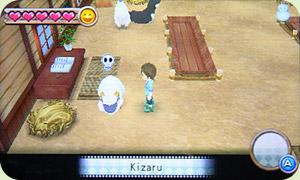
The blue bar on the animals' profile screen will display the amount of stress they have. The more blue bar there is, the higher the animal's stress level is. Stressed animals will become sick and could possibly die if left untreated.
The bar has a maximum of 100 stress points. Once the bar reaches 50 points (50% full), the animal has a 10% chance of becoming sick the next morning. At 70 points this increases to a 30% chance of becoming sick. From 80 to 90 points there is a 50% chance and anything above 90 stress points is an 80% chance. Even if the animal has a full 100% blue stress bar, there is still a slight chance (20%) that it won't be sick the next day.
Many of the activities that decrease animal friendship will also increase animal stress.
- Ignore the animal for more than two days: Your standard animals don't mind not being talked to, but the higher level animals are
desperate for attention! Make sure you talk to them at least once every two days. The cows also want to be milked on a regular basis, but
the fluffy critters don't mind not being sheered.
- Not Talking Stress Gained: +5 for Chickens, Cows, and Sheep. +10 for Jerseys and Yak. +30 for Silkies, Suffolk, Alpacas, and Llamas.
- Not Milking Stress Gained: +10 for Cows. +20 for Jerseys and Yaks.
- Hit an animal with your farm tools: They don't like it! You probably know that by now!
- Stress Gained: +3 for Sheep. +10 for Chickens, Silkies, Cows, Jerseys, and Yaks. +20 for Suffolk, Alpacas, and Llamas.
- Not fed at all that day: Besides losing Friendship Points for going hungry, you'll also increase the animals' stress levels. Make
sure you don't run out of Chicken Feed for your Silkies.
- Stress Gained: +5 for Chickens. +10 for Cows, Jerseys, Yaks, Sheep, Suffolk, Alpacas, and Llamas. +30 for Silkies.
- Wrong outdoor weather while grazing: If you leave them outside during rainy or stormy weather, then you will earn stress for
every two hours they remain outside. Do not leave your poultry outside during a storm!
- Rainy Stress Gained: +3 for Cows. +5 for Chickens, Silkies, Sheep, Suffolk, Alpacas, and Llamas. +10 for Jerseys and Yaks.
- Stormy Stress Gained: +5 for Cows. +10 for Sheep, Suffolk, and Llamas. +20 for Jerseys, Yaks, and Alpacas. +100 for Chickens and Silkies.
- Left outside overnight: These stress points will be added to the stress bar in the morning when you wake up if you left your
animals outside on a sunny or snowy day. Make sure you have the animals back into their barns before 9:00 pm. If you leave your animals
outside on a rainy or stormy day, then you've enough stress racked up anyway; remember the stress bar maximum limit is 100 points and
won't rollover stress points for a second stress bar.
- Stress Gained: +15 for Cows. +20 for Chickens, Silkies, Sheep, Suffolk, Alpacas, and Llamas. +30 for Jerseys and Yaks.
- Left inside all day: When the weather is sunny or snowy, the animals will want to go outside. If you leave them inside, then they
will gain stress the next day. It isn't a lot of stress, but it's enough to get their point across: "take me outside!"
- Stress Gained: +3 for Cows. +5 for Chickens, Silkie, Sheep, Suffolk, and Llamas. +10 for Jerseys, Alpacas, and Yaks.
- Disturbed after going to sleep: Animals will doze off after 9:00 pm at night. If you move them after that time, you will
wake them up. I don't like being woke up once I've fallen to sleep, and neither do your animals! Animals who are disturbed will gain
some stress, even if your intention was to push them back into the barn at night to avoid overnight stress.
- Stress Gained: +5 for Chickens, Cows, Jerseys, Yaks, Sheep, Suffolk, and Llamas. +10 for Alpacas. +20 for Silkies.
- Dirty coats / lack of brushing: Every three days your livestock animals will become dirty. The animal will start out
as Clean, then become Dirty, and after another three days will be Filthy. An unclean animal will gain stress every two days. You can
resolve their clean status by using the Brush. Chickens don't become unclean.
- Dirty Status Stress Gained: +3 for Sheep. +5 for Cows, Jerseys, Yaks. +20 for Suffolk, Alpacas, and Llamas.
- Filthy Status Stress Gained: +7 for Sheep. +10 for Cows, Jerseys, and Yaks. +30 for Suffolk, Alpacas, and Llamas.
When an animal becomes sick, its stress will automatically fill to 100 points. Sick animals will remain inside their barns and will not exit the barn during the routine pet herding. To cure the sickness, buy Animal Medicine from Neil's Animal Shop for 840 G each.
You don't have to heal the animal right away; it will take several days of neglect before the animal will die. Silkies will die after three days if you don't use the Animal Medicine, and Chickens will take four days. Suffolk and Alpacas take five days to die, Sheep will die after six days of sickness, Jerseys take seven days, Cows take eight days, Llamas take nine days, and Yaks take 10 days before they kick the bucket. If Neil's shop is closed on the day your animals become ill, there's no need to panic. Your animal will be fine as long as you buy and use the medicine before their time is up.
If you do allow your animal to pass away because of a curable illness, you will lose friendship with your remaining animals and -1000 FP with each of the villagers.
Ideally, you do not want any blue displayed on the stress bar. If you do see stress appear, there are things you can do to decrease the bar:
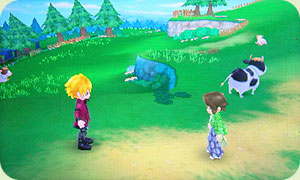
- Animal interaction: Simply talking to your livestock or picking up your chickens will help to lower their stress. Brushing
the livestock also lowers stress and cleans their coats.
- Stress Lost From Picking Up: -5 for Silkies. -10 for Chickens.
- Stress Lost From Talking: -5 for Jerseys, Yaks, Suffolk, and Llamas. -10 for Cows and Sheep. -20 for Alpacas.
- Stress Lost From Brushing: -10 for Llamas and Suffolk. -15 for Jerseys and Yaks. -20 for Cows. -30 for Sheep and Alpacas.
- Spending time outdoors: Take the animals outside on sunny or snowy days to raise their Friendship Points and lower stress.
For every 2 hours spend outside the animal will lose stress. You can use this outside time to repair any stress you've gained for
ignoring the Cows, Sheep, and Chickens. For example, a Chicken will gain +5 stress for not interacting with it for two days, but you'll
just lose that stress when they go outside. Basically, you can completely ignore Chickens, Cows, and Sheep if you've got
other things you'd rather do in your game and you have pets assigned to herding your animals.
- Stress Lost: -3 for Jerseys and Yaks. -5 Silkies, Suffolk, Alpacas, and Llamas. -10 for Chickens and Sheep. -15 for Cows.
- Visiting Neil's Animal Sanctuary: For 100 G each, you can take your livestock animals (but not your chickens) to the special animal pasture. Going to the sanctuary will reset the animals' stress to zero! You don't have to stay at the sanctuary for any certain amount of time. If you don't want to pay Neil, or if his shop isn't open, you can quickly reset your animals' stress to zero by using the Wifi Trading System. Select up to five animals to enter into the wifi sanctuary and when you exit, your animals' stress will be 0 points. Using the wifi is free; you just need to set up your Nintendo 3DS to utilize it.
Lifespans
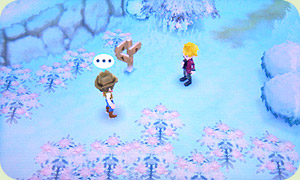
Your animals will die eventually; it isn't something you can avoid. The more hearts of friendship your animals have, the less chance that they'll die when you awake in the morning. There is always a small chance that the animal will pass away when they are at least two or three years old. Chickens, Sheep, and Suffolk have a minimum natural lifespan of two years, while the other animals have three years. All of the animals have a maximum lifespan of eight years.
If your animals have 10 hearts of friendship, then you should expect:
- Chickens and Sheep: 4 to 8 years
- Silkies, Cows, Suffolk, and Alpacas: 5 to 8 years
- Llamas: 6 to 8 years
- Jerseys and Yaks: 7 to 8 years
You will learn about an animal death in the morning when you wake up. Neil will visit your house and tell you about the passing. Only one animal can die per day. If you had saved your game the night before going to bed, then you can reload your save game to see if your animal survives the night. An animal that is dying of natural causes may survive if it hasn't reached its eighth year of age, but if it is because of an uncured sickness then there's nothing you can do.